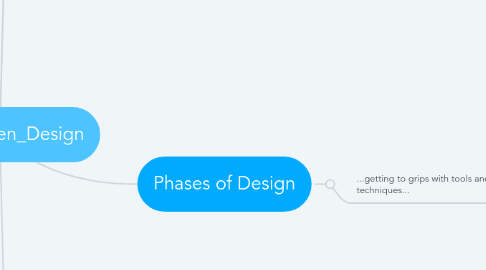
1. Starting Points
1.1. Accessing Tools
1.1.1. Download KNIME
1.1.2. Download Power BI Desktop
1.2. Accessing Course Materials
1.2.1. Access this Mindmap
1.2.1.1. https://bit.ly/SMU_DDD
1.2.2. Copy this Mindmap
1.2.3. Notes
1.3. Recapping Course Objectives
2. Framing
2.1. ...seeding some important perspectives...
2.1.1. Design
2.1.1.1. ...design is a process and different process frameworks have developed to address different design challenges...
2.1.1.1.1. Design Processes
2.1.1.2. ...there are two very dominant viewpoints in this spectrum...
2.1.1.2.1. Design Thinking for Service Design
2.1.1.2.2. Six Sigma for Process Design
2.1.1.3. ...but design is increasingly "data-driven" in a digital economy and this has eroded tribal boundaries...
2.1.1.3.1. Kayak A-B Tests
2.1.1.3.2. German Rail
2.1.1.3.3. Triggr Health
2.1.1.4. ...we can see some interesting fusions of "hard" and "soft" design approaches in leading organisations...
2.1.1.4.1. "Uber Engineering is committed to developing technologies that create seamless, impactful experiences for our customers..."
2.1.1.5. ...in summary we can look to complexity theory to guide us through the selection of specific design techniques for specific contexts...
2.1.1.5.1. The Cynefin Model
2.1.2. Two Views
2.1.2.1. ...throughout the course we are going to explore the similarities and differences between two design approaches...
2.1.2.1.1. Design Thinking
2.1.2.1.2. CRISP
3. Phases of Design
3.1. ...getting to grips with tools and techniques...
3.1.1. Insight
3.1.1.1. ...the objective of the "Insight" phase is to develop "Systemic Understanding"...
3.1.1.1.1. Design Thinking
3.1.1.1.2. Data Science
3.1.1.2. ...it is useful to reflect on the differences and complementarities of design thinking and data science approaches...
3.1.1.2.1. Revealing Systemic Insights
3.1.1.2.2. Capturing Cause and Effect
3.1.2. Idea
3.1.2.1. ...the objective of the "Ideation" phase is to craft a response to the insights gathered...
3.1.2.1.1. Design Thinking
3.1.2.1.2. Data Science
3.1.2.2. ...it is useful to reflect on the differences and complementarities of design thinking and data science approaches...
3.1.2.2.1. Exploratory Nature of Design Thinking
3.1.2.2.2. Constrained "Predict and Prescribe" Intent of Machine Learning
3.1.3. Action
3.1.3.1. ...the objective of the "Action" phase is to translate and package our ideas in a way that generates meaningful impact...
3.1.3.1.1. Design Thinking
3.1.3.1.2. Data Science
4. Working with Tableau
4.1. ...familiarisation with Tableau...
4.1.1. Download the Dataset
4.1.2. Open Tableau
4.1.3. Connect to Excel
4.1.4. Select "Superstore"
4.1.5. Drag Data Tables to the Data Sources Canvas
4.1.5.1. ...details...
4.1.5.1.1. Orders
4.1.5.1.2. People
4.1.5.1.3. Returns
4.1.6. Configure the Table Relationships
4.1.6.1. ...details...
4.1.6.1.1. Review Cardinality
4.1.6.1.2. Set Performance Options
4.1.7. Go to Worksheet
4.1.7.1. ...orientation...
4.1.7.1.1. Data Tab
4.1.7.1.2. Analytics Tab
4.1.7.1.3. Chart Canvas
4.1.7.1.4. "Show Me" Chart Chooser
4.1.8. Build Charts
4.1.8.1. ...chart...
4.1.8.1.1. Orders[Sales] > Columns
4.1.8.1.2. People[Region] > Rows
4.1.8.1.3. Returns[Returned] > Colour
4.1.8.1.4. Toggle Show Me to Stacked Bar
4.1.8.2. ...chart...
4.1.8.2.1. New Worksheet
4.1.8.2.2. Orders[Sales] > Columns
4.1.8.2.3. People[Person] > Rows
4.1.8.2.4. Orders[Category] > Colour
4.1.8.2.5. Toggle Show Me to Side by Side Bar
4.1.8.2.6. Review Measure Settings
4.1.8.2.7. Review Dimesnion Settings
4.1.8.3. ...chart...
4.1.8.3.1. New Worksheet
4.1.8.3.2. Orders[Sales] > Columns
4.1.8.3.3. Orders[Quantity] > Rows
4.1.8.3.4. Analysis Tab > Disaggregate
4.1.8.3.5. Orders[Category] > Colour
4.1.8.4. ...chart...
4.1.8.4.1. New Worksheet
4.1.8.4.2. Orders[Order Date] > Columns
4.1.8.4.3. Orders[Sales] > Rows
4.1.8.4.4. Toggle Show Me to Lines
4.1.8.4.5. Orders[Sales] > Drop Down > Quick Table Calculation > Running Total
4.1.8.4.6. Orders[Order Date] > Drop Down > Toggle Date Representation
4.1.8.4.7. Chart > Year > Click "+"
4.1.8.4.8. Orders[Category] > Colour
4.1.9. Create Dashboard
4.1.9.1. ...details...
4.1.9.1.1. New Dashboard
4.1.9.1.2. Uncheck Maximum Size
4.1.9.1.3. Drag Charts to Canvas
4.1.9.1.4. Review Presentation Options
4.1.9.1.5. Review Share Options
4.2. ...development of EDA capability...
4.2.1. Hans Rosling and Gapminder
4.2.1.1. ...more details...
4.2.1.1.1. Gapminder in Tableau
4.2.2. Download the Data
4.2.3. Open Tableau
4.2.4. Connect to Text
4.2.5. Select "gapminder"
4.2.6. Drag Tables to Data Sources Canvas
4.2.7. Create Calculated Field using Field Drop Down Menu
4.2.7.1. ...details...
4.2.7.1.1. IFNULL(SUM([Population]), PREVIOUS_VALUE(0))
4.2.7.1.2. IFNULL(SUM([Income]), PREVIOUS_VALUE(0))
4.2.8. Go to Worksheet
4.2.9. Build Chart
4.2.9.1. ...the core gapminder visual...
4.2.9.1.1. Columns = (New) Income
4.2.9.1.2. Rows = Life
4.2.9.1.3. Filter = Year
4.2.9.1.4. Disaggregate at Analysis Tab
4.2.9.1.5. Size = (New) Population
4.2.9.1.6. Colour = Region
4.2.9.1.7. Edit Axes
4.2.9.1.8. Drag Year to Pages
4.2.9.2. ...develop visual...
4.2.9.2.1. K-Means
4.2.9.2.2. Correlation Coefficients
4.3. ...running EDA tasks...
4.3.1. EDA Framework
4.3.1.1. EDA helps us to uncover the underlying structure of the dataset, identify important variables, detect outliers and anomalies, and test underlying assumptions...
4.3.2. Download the Data
4.3.3. Review Skewness and Kurtosis
4.3.3.1. ...steps...
4.3.3.1.1. Drag a Measure to Column and Toggle to Histogram
4.3.4. Centrality and Variance
4.3.4.1. ...steps...
4.3.4.1.1. Drag a Measure to Column and a Dimension to Row, Toggle Measure Type
4.3.5. Relationship
4.3.5.1. ...details...
4.3.5.1.1. Drag a Measure to Column, and a Measure to Row, and Toggle Aggregation
4.3.5.1.2. Drag a Sequence of Measures to Column, and a Sequence of Measures to Row, and Toggle Aggregation
4.3.5.1.3. Drag a Dimension to Column, a Dimension to Row, and "the" Count to Text, Select Heatmap or Highlight, Toggle Count Representation
4.4. ...task...
4.4.1. Perform a standard EDA on the "Transport" dataset...
4.4.1.1. ...details...
4.4.1.1.1. Download the Data
4.4.1.1.2. EDA Framework
4.4.2. Perform a standard EDA on the "Cycling" dataset...
4.4.2.1. ...details...
4.4.2.1.1. Download the Data
4.4.2.1.2. EDA Framework
